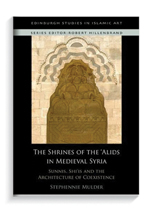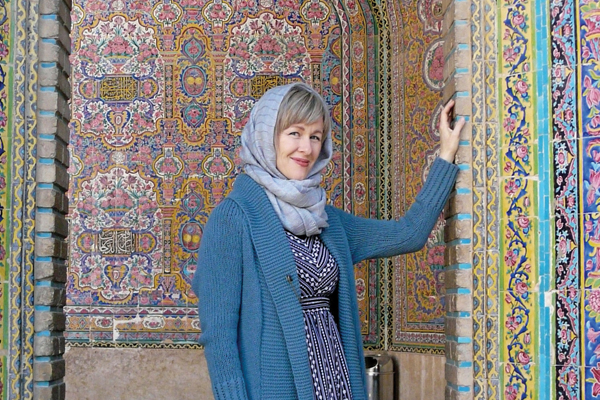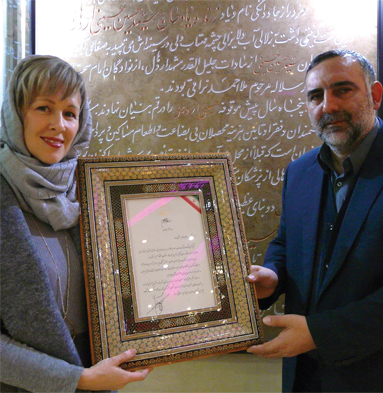Stephennie Mulder, an associate professor in the Departments of Art and Art History and Middle Eastern Studies, was invited to Tehran, Iran, in February 2016 to receive the country’s World Award for Book of the Year from the Iranian Ministry of Culture, which was to be awarded in a ceremony by Iranian President Hassan Rouhani. Her book, The Shrines of the ‘Alids in Medieval Syria: Sunnis, Shi’is, and the Architecture of Coexistence, explores multiple shrines in Syria and how the architecture tells a story that complicates the traditional narrative of the divide between Sunnis and Shi’is in the country. The following are excerpts from Mulder’s description of her journey and preservation efforts.
To be honest, getting this news was a bit complicated. Of course my first response was to be thrilled my work had received international recognition. And it’s always been a dream of mine to go to Iran, which is a spectacularly beautiful country, rich in history.
Americans are free to travel to Iran and are usually received warmly. But it is sometimes challenging to get a tourist visa. So as an art historian, I saw the invitation as an exciting opportunity, and even decided to take my 9-year-old daughter with me.

But then the political reality of the prize dawned on me, and I realized that I wasn’t sure if I wanted to accept the prize. Iran is a key supporter of the Assad government in Syria, and it’s Assad (not ISIS), who has killed the majority of civilians in Syria. I worked for more than 12 years in Syria, have lost friends in the war, and have many close friends whose lives have been profoundly impacted by a war in which Iran’s support has been a key factor.
On the other hand, the prize had been awarded by a group of Iranian scholars for a book that was about the power of architecture to unify, and I thought it was meaningful that they had chosen this book in this moment of conflict. I asked a number of Syrian friends for their thoughts and surprisingly there was universal support for my going — partly for the chance to tell a different story to Iranians I might meet about the Syrian people. In the end, I decided to go and to donate the $10,000 prize to a charity that supports Syrian mothers and children.
Once I had made that decision, I was faced with two problems. First, it turned out that the receipt of a cash prize from the Iranian government is prohibited under U.S. sanctions legislation. Second, the awards ceremony was just two weeks away, and the Iranian visa seemed unlikely to come through in time.
The next two weeks were quite a drama. For the license I had to get clearance from the Departments of Treasury and State, a process that normally takes up to five months. It looked impossible. But at that point a group of wonderful people stepped in and worked incredibly hard to get me there — David Ivey in the Office of Sponsored Projects, UT’s security analyst Jess Miller, as well as Dean Randy Diehl, Art and Art History Chair Jack Risley, and Dean Douglas Dempster.

On David’s suggestion I wrote a letter to Congressman Lloyd Doggett, asking his office to petition the Department of Treasury on my behalf. Representative Doggett’s office must have some clout, because two days later I got a call from a Treasury Department officer who rushed the application through just days before the ceremony in Tehran.
It seemed like a miracle. Only one problem: We had a flight but still didn’t have our Iranian visas! In the end, we missed our original flight, but the visa came the next day. There was no way I was canceling the trip after all that, so that morning I purchased same-day tickets to Tehran for my daughter and me. We missed the awards ceremony itself, but given my ambivalence about the situation, I think it all turned out okay in the end.
It was important to go because I wanted to recognize the gesture of the Iranian committee in choosing this book about sectarian relationships. Although the Syrian conflict is not primarily a sectarian one, it began as part of the Arab Spring movement of 2011 and was a revolutionary political uprising that aimed to overthrow the Assad government. But the uprising was met with a brutal government crackdown, and the situation quickly deteriorated into civil war. In that context, sectarianism, though not the cause of the war, has been used to manipulate people’s fears in Syria and — as I learned on my trip — also in predominantly Shi’i Iran.
Though Iranians have access to global media, many Iranians I spoke to, including the well educated, seemed genuinely surprised when I told them that Assad was bombing his own civilians — though this is a fact that’s widely attested by multiple international organizations. They were somehow under the impression that their Iranian Shi’a government was fighting the Sunni-identified terrorist group ISIS in Syria.
Most Iranians are Shi’a, so the war as they understand it does have a sectarian connotation. I wonder if the Iranian awards committee was interested in my book for its story of Sunni-Shi’i sectarian cooperation in Syria and because it invites us to rethink the history of sectarianism in Islam.
Although I had never traveled to Iran, I study it and I have many Iranian friends, colleagues and students, so besides the Iranian misperception of the Syrian conflict, not too much surprised me. But when my Texan daughter discovered Mexican street corn is a thing in Tehran — that surprised both of us!
I think most Americans would be surprised to learn a few things. For example, Iranians welcome American tourists. Everywhere we went we were warmly received. I think my daughter was hugged, kissed and photographed hundreds of times. The repressive government with its strong anti-American sentiments is a reality — but like any place, the government’s propaganda doesn’t necessarily reflect the range of how individual Iranians feel.
Iran has a vibrant political opposition and had its own Arab Spring-style uprising (the Green Movement) in 2009. Many Iranians want a more open and just society, and many are risking their lives fighting to create it.
Iran is also an ancient country with a spectacular cultural heritage and lively and dynamic cities with flourishing art and music scenes: a place where it’s normal for 7-year-old kids to recite 11th-century poetry from memory.
The Tehran Museum of Contemporary Art has one of the largest collections of contemporary art outside Europe and the U.S. The seat of ancient empires from Darius to Alexander the Great, Iran is home to 19 UNESCO World Heritage Sites and dozens of national parks and wildlife refuges. Have I mentioned the food? Persian food! Saffron, turmeric, kashk, pistachios, rosewater! In short, it’s a pretty great place to visit.
One site I was especially excited about was Naqsh-e Rustam, an ancient Iranian necropolis with a number of rock-carved reliefs depicting Achaemenid and Sassanian rulers accepting tribute from conquered Roman emperors. I teach about these sites every year in my classes at UT, and it was incredible to actually get to experience them.
Cultural Preservation Heritage
In the fall of 2014, as ISIS began to systematically destroy cultural heritage sites in Syria and Iraq, I felt helpless as sites I had visited, researched and loved were being quickly obliterated. I called a meeting at UT to raise interest and awareness to the problems of cultural heritage destruction. Attended by more than 50 people, it led to the founding of the UT Antiquities Action group.
We sponsor educational events, films and speakers, and we plan various “actions” that are designed to raise awareness of the issues surrounding endangered cultural heritage. Last spring, for example, we visited the Austin office of U.S. Rep. Michael McCaul, chairman of the House Committee on Homeland Security, to deliver a petition to support a law before Congress designed to prevent the import of looted antiquities from Syria.
On April 2, we hosted our first one-day symposium, “Global Initiatives Toward Cultural Heritage Preservation: Who Owns the Past?” The group is open to anyone at UT and beyond. Please join us!

